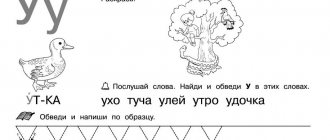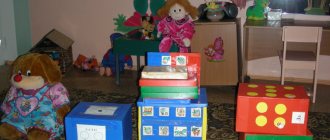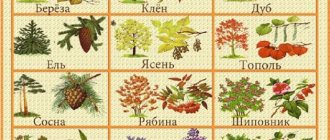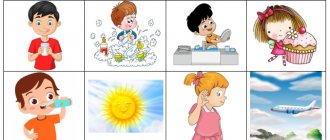Literacy training. 1 class. Object and word
Lesson summary in 1st grade.
Object and word. Goal: to create conditions for students to develop the ability to distinguish between an object and the word denoting this object, and to become familiar with the sound patterns of words. Planned results: Subject-related: students will learn to distinguish between an object and a word, and work with the sound patterns of words. Personal: positively participate in group and pair work, know how to communicate with the teacher and each other, and observe the norms of speech etiquette. UUD: Regulatory: they accept a learning task, correlate their actions with this task, look for a way to solve it, carrying out tests. Cognitive: consciously and voluntarily construct speech utterances in oral form, structure knowledge (a word in the form of a sound pattern), correlate an object with the sound pattern of a word. Communicative: take into account different opinions and strive to coordinate different positions in cooperation. 1. Organization of the beginning of the lesson. The long-awaited bell rang and the lesson began. Every day - always, everywhere, in class, in play. - We speak boldly, clearly and sit quietly. 2. Articulation gymnastics. 1) Once upon a time there lived a tongue in his house. He woke up early in the morning, opened the window, looked at the weather, and then hid in the house again. Description of the exercise: smile, open your mouth; stick out your tongue strongly and then hide it (do not close your mouth!). Repeat 3-4 times. 2) Then Tongue looked to the left, looked to the right: were children walking on the street? Description of the exercise: smile, open your mouth, stretch your tongue to the glue corner of your mouth, then to the right. Repeat 6-8 times. 3) After that, I looked down the tongue from the window: were there any puddles? And then up: is the sun shining? Description of the exercise: smile, open your mouth, lower your tongue down to your chin, then raise your tongue to your nose. Repeat 4-5 times. Make sure that your mouth is open at all times and that your lower lip does not help your tongue rise up. 4) Tongue saw that the weather was good and ran for a walk in the yard. I had just stepped off the porch when I heard someone rustling in the grass. Tongue looked more closely: needles were sticking out of the grass. It was... a hedgehog. He ran in circles in the grass: first in one direction, then in the other. Let's show how the hedgehog ran. Description of the exercise: make circular movements with the tongue between the lips and teeth in one direction or the other. The mouth is closed. — Pure saying “Stork” The stork learned the alphabet and got an A. And today, without prompting, he reads fairy tales to himself. 3. Repetition of what has been learned - What helps people communicate? (speech) - What groups can speech be divided into? (oral and written) -What do you know about oral and written speech? Give examples. -What does speech consist of? (from sentences) -Look at the diagrams. What do they have in common? What is the difference? (sentences consist of words, at the end of the sentence there are different signs, different numbers of words) 4. Assimilation of new knowledge - Open the Primer on page 14. Look at the drawing. Find the objects drawn on it. What kind of leaves are attached to each item? (names) - Who gave names to all objects? (people) - Do all objects have names? Check it out in pairs. Alina, read the “cherry” task. - Ksyusha, read the poem. - What appeared first - the object or the word? (first a new object appears, and then people come up with a name for it) - When your grandmothers were little, they did not know such words as computer, navigator. Why? (these items did not exist yet) 5. Distinguishing the concepts of “object” and “word” - Now I ask two students to come to the board. To Masha I am an object - a pencil, and to Artyom - a word, the name of this object. - What can be done with the item? (put down, break, drop, sharpen) - What can you do with another pencil, with a word? (read, cross out, circle) 6. Introduction of the concept of “sound scheme of a word” (electronic textbook) - While we do not know how to write all the words correctly, so we will use schemes. Let's say out loud the names of the objects shown in the pictures. LLLLUUUUUKKK SSSLLLOOOONNN KRRROOOOT - How to write down the sound pattern of a word? (by the number of sounds) - Tell me, what is important in the scheme? (figure or number of sounds?) -Scientists agreed to write down the diagram using squares. There are as many squares as there are sounds in a word. 7. Determining the number of sounds in a word. - Look at the pictures and see what objects are depicted on them. Name the names of objects that correspond to 1, 2, 3 schemes. ball, cheese, lion, elephant, rose, mushroom, goat, pear, plum, lemon 8. Work in a notebook. Pinning Page 7 No. 1 - Which item has the longest name? And the shortest? Please note that words may vary in length. The size of a word does not depend on the size of an object. No. 2 himself - What types of pipes are there? (plumbing, telescopic, stoves on the roof of houses, musical) -Crane? (construction, plumbing) No. 3 -Make as per your choice. Draw a diagram of any word. To make it easier for you to draw, serifs are made on the top strip. Start drawing from the first cell. 9. Reflection - What new did you learn? -What difficulties were there? - Evaluate your work in class. Choose a picture for yourself: the sun - I understood everything, it was easy; sun and clouds - I understand, but I have questions; cloud - I don’t understand anything
We recommend watching:
Entertaining Russian language Test work in the Russian language, 1st grade Notes of a lesson in the Russian language in the post-primary period, 1st grade Notes of a lesson in the Russian language in 1st grade according to the Federal State Educational Standard
Similar articles:
Summary of the final extracurricular lesson in the Russian language in 1st grade
Lesson notes on the Russian language, 1st grade. Text. School of Russia
Lesson notes on the Russian language, 1st grade. The role of words in speech. School of Russia
Lesson notes on the Russian language, 1st grade. Polite words. School of Russia
Lesson notes on the Russian language, 1st grade. Single and polysemous words. School of Russia






